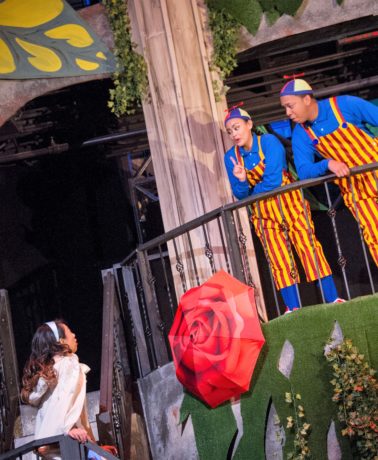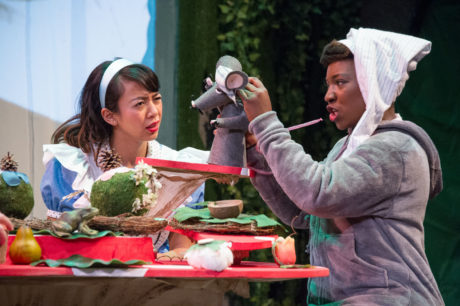Follow the White Rabbit down the rabbit hole for an enchanting Alice in Wonderland performance. It was a surreal evening on Friday evening, the Opening Night of Chesapeake Shakespeare Company’s production of Eva Le Gallienne and Florida Friebus’s adaptation of Lewis Carrol’s Alice in Wonderland, inside the theater building and just outside.

Ringing the block where the theater stands on South Calvert Street were dozens of heavy, white trucks and trailers, lighting equipment, film cameras, bucket lifts, black tents filled with monitor screens and control panels, craft service tables, police, and idling technicians, actors, and extras. They were filming scenes from upcoming episodes of the TV series House of Cards. It was an obstacle course, albeit a fun one, getting into the theater (and various techies were quick to tell us the Kevin Spacey character “has been killed off”).
Once inside, a different sur-reality took over. Alice in Wonderland, directed by Ian Gallanar, and supported by a creative, talented team, is a colorful voyage that allowed the audience to leave the world’s drama outside and focus on the travels and travails of an endlessly curious English girl named Alice.
It wasn’t nearly the same as stepping into a saccharine cartoon. This is a living, vibrant Alice where a prop might go flying over your head, or a character emerges from the dark to rush past you onto the stage. It is an Alice that actively engages, thoroughly entertains and fascinates audiences of all ages. It is not a kiddie show. It’s a must-see show.
Audience members enter the theater to see the play is seemingly already in progress. It’s a short musical performance, part of the evening’s repertoire, by Music Designer Grace Srinivasan, as an opportunity to warm-up to some of the characters, like Michael Toperzer’s nervous White Rabbit, strumming a guitar and singing – what else? – Grace Slick’s “White Rabbit.” Plus, winning renditions of Paul McCartney’s “English Tea” and Harry Nilsson’s “Mr. Richland’s Favorite Song.”

A group of characters then broke into singing “Happy Un-Birthday” to a woman in the audience, while reminding her un-birthdays are more important than birthdays as they happen 364 times more often than a birthday. Silly but so savvy.
Their playing, twisting, teasing and torment of the English language would continue throughout the evening. And, later on, the audience is treated to four songs with lyrics by the playwrights and composed and arranged by Ian Gallanar, who is also Alice’s sound designer.
As the pre-show show ended, the stagehands, as much characters as the actors, moved props onto the stage to set up the “mirror set” illusion with two identical armchairs, chessboard tables, red bound books and one standing mirror frame.
So, what is Alice? It is faithful to the timeline of the original books by Charles Lutwidge Dodgson, a.k.a. Lewis Carroll, and its adaption into a play by Galliene and Friebus, but with the insertion of a 21st Century energy and way of looking at the world.
The stage, with a set designed by Chester Stacy, rises to three levels, and feels like a wooded wonderland, dotted with umbrellas photo-printed with images of Cabbage Roses, Black-Eyed Susans, and other flowers. There are hanging vines and moss, plus ancient columns rising up.
Stage Right, a large vertical screen stretched from the second to third level. Below it, a narrower one flanked one side of the main entry and exit for the characters. The screens, with imagery projected by Technical Director Daniel O’Brien, are in use throughout the performance. A slit in the lower screen turns it into an actual character as a gloved hand thrusts occasionally through the opening to offer props to Alice.
The costumes in the show are a marvel, well-designed and constructed, and instantly identify each character, yet comfortable enough to allow the actors to do their often-athletic maneuvers. Punctuating the costumes are the wigs, hairstyles, and eccentric makeup designed by Sandra Spence.

Other key elements are the sweat equity of Lighting Designer Katie McCreary, and Dance Choreographer Nellie K. Glover, and, especially, Jess Rassp, the properties and puppet designer, who designs puppets with at least one funny bone, except the dark, menacing Jabberwocky.
Alexandra Palting realistically portrays Alice, and is the sole thespian with only one role. The fifty or so other characters are adeptly handled by the rest of the cast, each of whom performs multiple roles and double as puppeteers.
As the show begins, Alice, playing with a furry black cat puppet, has decided to see what life is like on the other side of the looking glass. The mirror starts to ooze smoke, and she steps through. Meeting a mouse puppet, she quickly learns not to discuss her cat’s fondness for eating mice or rats.
The young girl, in short order, meets a vamping and vaping Caterpillar (JC Payne – who is also Tweedle Dum), a Duchess (Donna Ibale, also portrays Tweedle Dee), and Vince Eisenson as the Mad Hatter.
March Hare (Robby Rose) hops by and Alice eventually interacts with Humpty Dumpty (Terrance Fleming), the Mock turtle (Gregory Atkin), and the self-absorbed King and Queen of Hearts (Steven Hoochuk and Briana Manente). That’s just for starters. However, the croquet game, played with pink flamingos, with Alice and the King and Queen of Hearts is worth the price of admission.
The Mad Hatter’s (Vince Eisenson) Tea Party is a hoot. So, too is the ongoing dissection of our language. Of the Mock Turtle, one character explains: “We called him a tortoise because he taught us.” Later on, another character points out: “… that’s why we call them lessons because they … lessen from day to day.”
Among the innovative props was one used by Alice and other characters: A keyboard inserted into a mock log on a stand. It made beautiful music. The thought and craftsmanship that went into creating that single instrument is typical of each and every prop, puppet, costume, and accessory utilized in the show. Simply a marvel.
Parking is available at Arrow Parking, 204 East Lombard Street, during evening, Saturday, or Sunday performances for only $5 IF you get a coupon from an usher inside the theater.
Running Time: Two hours and 25 minutes, including one 15-minute intermission.
Alice in Wonderland runs through May 27, 2018, at the Chesapeake Shakespeare Company – 7 South Calvert Street, in Baltimore, MD. For tickets, call the box office at 410-244-8570, or purchase them online.




